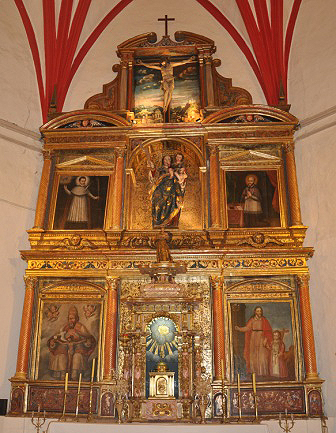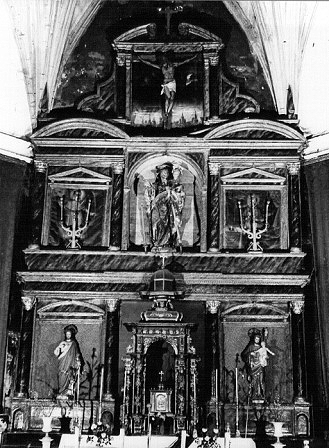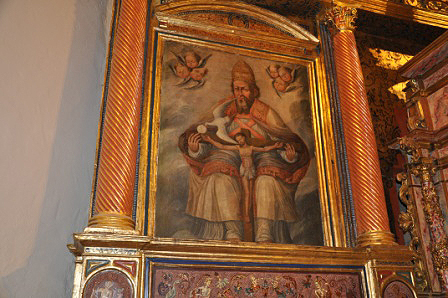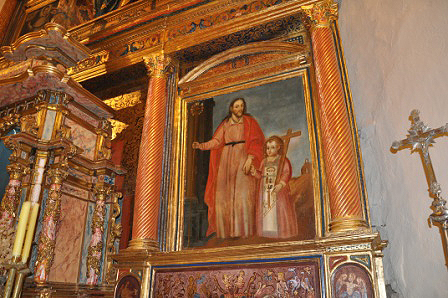The piece of the month of August 2015
THE MAIN ALTARPIECE OF THE CHURCH OF NUESTRA SEÑORA DE LA VICTORIA DE CASCANTE
Mª Josefa Tarifa Castilla
University of Zaragoza
The church of the primitive convent that the order of the Minim friars founded in Cascante upon their arrival in 1586, now the parish church of Nuestra Señora de la Victoria, has been presided over since the first quarter of the 17th century by a main altarpiece that until recently we knew nothing about. The enquiry of the documentation conserved in different Navarrese archives has allowed us to know the different artists who took part in its elaboration, as well as the contract of execution.
As had been established in the founding deed of the convent, the board of trustees of the main chapel had been reserved to the local regiment, so that in addition to bearing the expenses of the execution of its construction, completed around 1605, it should also be made position of the ornamentation of the presbytery. In July 1621, the committee Real de Navarra granted permission to the town of Cascantina to spend 200 ducats of its income on the construction of the main altarpiece, although before auctioning the work, they were to be made aware of the different models presented for this purpose.
The work was auctioned in the town hall on August 22 of the present year, and different masters of architecture and painting, the best that worked in the area of the Ribera de Navarra and the region of Tarazona, came to the town and presented up to six different traces with which to undertake this piece. The aldermen commissioned the Pamplona artist Juan de Lumbier (act. 1578-†1626), one of the most outstanding Navarrese painters of the last third of the 16th century and the beginning of the 17th century, who was based in Tudela, the architect Francisco del Pontón and Juan de Biniés, a sculptor living in Tudela, to choose the most suitable one from among all the designs presented.
The masters selected the two designs they considered most appropriate and least expensive to make the project a reality, one on parchment signed by Jerónimo de Estaragán, a master active in La Ribera who worked in the decade of 1630-1640 making classicist altarpieces, and the other drawn on paper by Juan de Irigoyen y Macaya, to which were added the capitulas for the execution of the altarpiece. According to these, the artist who was awarded the piece of furniture would carry it out following one of the two pre-selected designs, in which besides the tabernacle, would be present the representation of St. Francis of Paula, the Virgin of Our Lady of Victory, St. Francis of Assisi with the wounds, St. Dominic, St. John the Baptist, St. John the Evangelist and a crucified Christ in the attic.
For its execution, pine wood "from Ebro, of good quality and dry" would be used, while the painting that would cover it would be oil and gilded, leaving the whole architecture of the altarpiece covered with smooth, well burnished gold. The master who finished it off was to conclude it within four years, charging 50 ducats annually until the total amount of the contract was paid, the work being recognized after its conclusion by masters appointed by both parties who would corroborate or not its execution of agreement to the chapters and design chosen in this regard. Different masters bid in the auction, such as Juan de Berganzo (doc. 1601-1625), assembler neighbor of Tarazona, the painter Juan de Lumbier, Juan de Gurrea, assembler neighbor of Tudela and founder of a workshop of important retablists in Tudela in the first decades of the XVII century, or the Cascantino Juan de Gessa, although the work was finally awarded to Bernardo del Bosque, neighbor of Tarazona, in 720 ducats.
This amount tripled the initial budget allowed to the Cascantino regiment, so that in September 1621 the prosecutor advised to reform the design "removing some things that are not of very great consideration". The Royal committee granted on December 11 of the same year the opportune licence to undertake the main altarpiece, in which they could spend only 300 ducats of the municipal revenues. Another of the masters who also participated in the elaboration of the altarpiece was Juan de Gurrea, specifically in the masonry or architecture of the furniture, at least since April 1623, for which he received 50 ducats the following year.

Main altarpiece. Church of Nuestra Señora de la Victoria in Cascante.
The altarpiece, with a straight floor plan, sits on a masonry plinth, occupying the central canvas of the polygonal apse. It is articulated in two sections of three streets, framed by columns of molded base, wreathed shaft and composite capital. The lateral boxes of the first body are topped by a curved pediment, while those of the upper floor have a triangular pediment, with the central street describing a semicircular arch on pilasters. A separating frieze is superimposed on this second level, culminating at the ends with a curved pediment and pyramidal finials. The attic, formed by a single central street crossed by columns of fluted shaft on which there is a curved split pediment, is joined to the lower floor by curved fins. Later the baroque tabernacle was added that occupies the low body of the central street, formed by pedestal and body of decorated columns, housing the tabernacle in its interior.
If the architecture of the altarpiece received polychromy it was late, at the end of the XIX century or beginning of the XX century, without having been previously stuccoed. A painting of subject plastic that imitated marbles of green and red colors, combined with the gilding of the bases and capitals, as we can see in some photographs prior to the 1990s. This was the aspect that the altarpiece presented until 1996, when it underwent an important intervention under the direction of the then restorer of the Museum of Navarra, Ángel Marcos, who eliminated the previous painting, stuccoing and water gilding, to polychrome and carry out fine works of tempera painting and sgraffito imitating fantastic decorative motifs of Renaissance style.
As far as the iconography of the altarpiece is concerned, the indications contained in the 1621 conditions were not followed to the letter, since most of the saints mentioned in the contract were not finally depicted on it. In addition, the paintings that the altarpiece currently houses may not be the original ones, since photographs taken before 1996 show that the side streets of the first body were occupied by the sculptures of the Sacred Heart on the left and Saint Joseph on the right, since the paintings intended for these spaces had been removed.

Photograph of the main altarpiece prior to the 1990s when the altarpiece was intervened on
At present, the left box of the first body contains a painting of the Holy Trinity, representing God the Father seated, holding with his two hands the cross on which Christ is nailed, accompanied by the dove of the Holy Spirit, while the one on the right side sample shows Saint Joseph with the Child, both standing, with the young patriarch holding Jesus by the hand.


Holy Trinity and St. Joseph with Child
In the second body of the altarpiece, on the right, there is a canvas of a saint martyr standing, with a sword stuck in his heart, holding in his left hand the palm of martyrdom, while with his right hand he points to the lamb represented in the upper part with the Latin registration In sanguine Agni, which we have identified with Pedro Arbués, inquisitor of Aragon, who was murdered in 1485 by a group of Judeo-converts while he was praying kneeling before the main altar of the Cathedral of Zaragoza. The other painting on the right side sample St. Francis de Sales (1567-1622), bishop of Geneva, great defender of Catholic doctrine against the Protestant Reformation in France, canonized in 1665 by Pope Alexander VII.
Contemporary to the architecture of the altarpiece are the sculptures that occupy the central street. On the one hand, the carving of the Virgin of Our Lady of Victory, with polychromy of the 18th century. Mary, standing, with her legs in contraposto, directs her gaze to the front, supporting Jesus in her left arm, leaning on her hip, while holding with her right hand the palm of victory. The child, with a tender look and black curly hair, wears a long-sleeved tunic that reaches his knees, showing his legs arranged in a complex posture, which gives movement to the figure. He extends his right arm forward while holding the ball with his left, helped by his mother.

Our Lady of Victory
Above this sculptural group the image of Christ crucified was placed in the attic, which the authors of the Catalog Monumental de Navarra link to the style of Juan de Biniés. A dead Christ, with a naked body of imposing muscular mass that seems to be inspired by classical statuary. The sculpture is arranged on a painting with a landscape of stormy clouds, with mountains in the background and buildings in the foreground made in great detail, such as a central building, articulated by buttresses and topped by a dome of orange average , for whose realization the painter would be inspired by engravings of the time.

Calvary
bibliography
-GARCÍA GAINZA, M.C., HEREDIA MORENO, C., RIVAS CARMONA, J. and ORBE SIVATTE, M., Catalog Monumental de Navarra, I. Merindad de Tudela, Pamplona, Institución Príncipe de Viana, 1980, pp. 51-52.
-FERNÁNDEZ framework, J.I., "Nuestra Señora de la Victoria. Cascante", Temas de Cultura Popular, nº 348, Pamplona, Diputación Foral de Navarra.
-TARIFA CASTILLA, M.J., El Convento de Nuestra Señora de la Victoria de Cascante, Cascante, association Cultural Amigos de Cascante "VICUS" and Government of Navarra, 2014, pp. 113-125.
